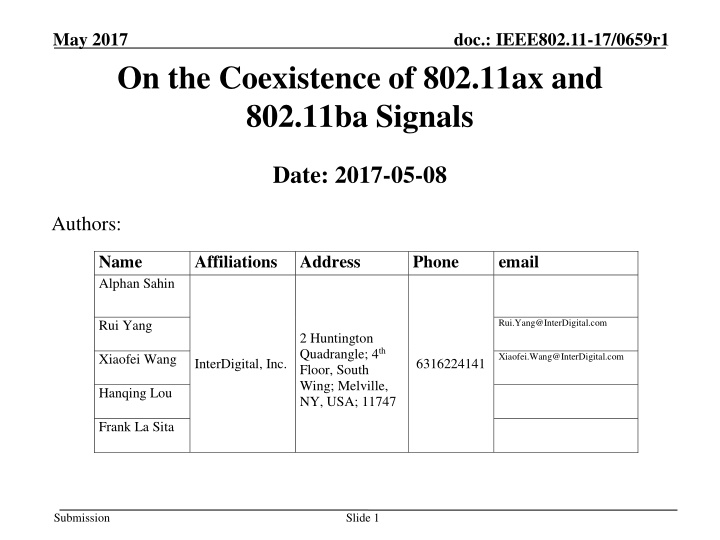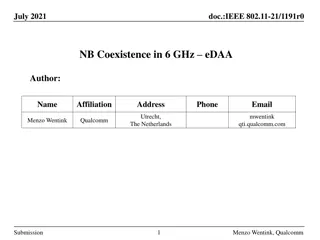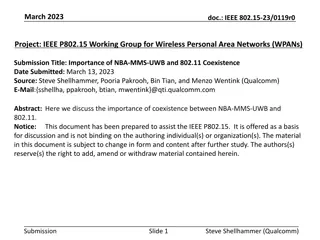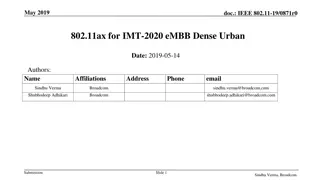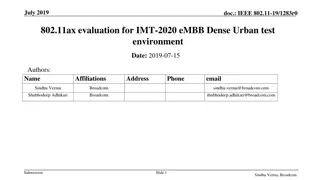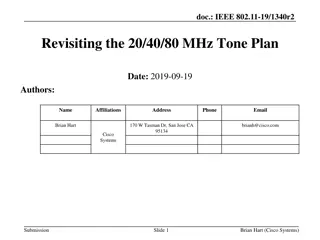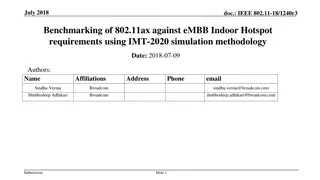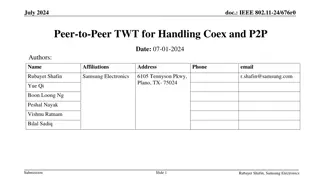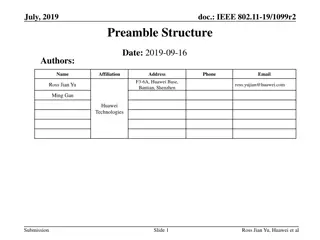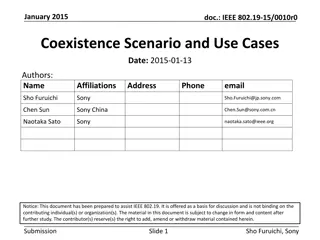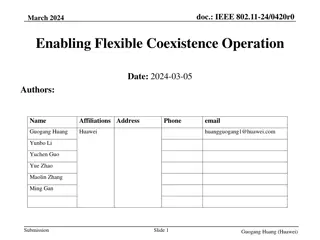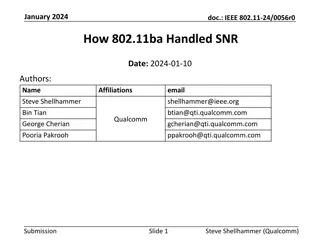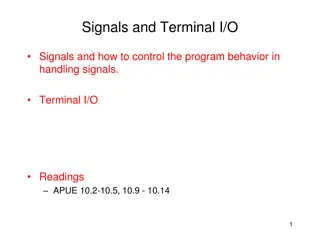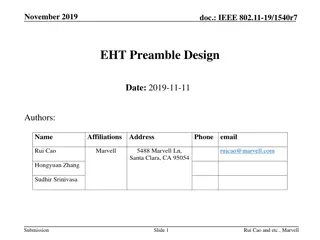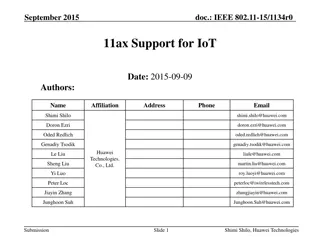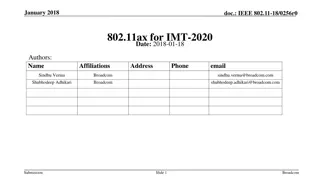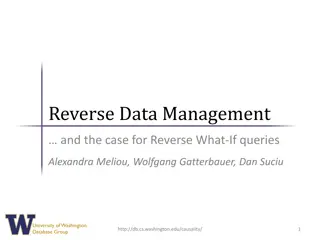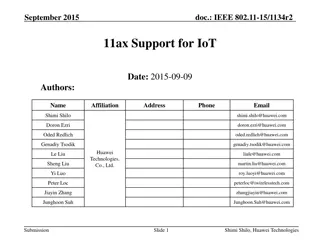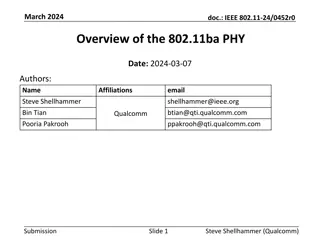Coexistence of 802.11ax and 802.11ba Signals
In this contribution, a narrow-band sequence-based OOK scheme with WFC is proposed to enable coexistence with 802.11ax transmissions without interference. The proposed solution involves generating WFC OOK symbols using a set of sequences in frequency based on the 802.11ax OFDM structure. This method aims to address the issue of incompatible numerologies and ensure orthogonality between OOK symbols and OFDM signals during concurrent transmissions. By incorporating specific sequences, the interference between 11ax OFDM and 802.11ba OOK symbols can be mitigated, enhancing the overall system performance.
Download Presentation

Please find below an Image/Link to download the presentation.
The content on the website is provided AS IS for your information and personal use only. It may not be sold, licensed, or shared on other websites without obtaining consent from the author.If you encounter any issues during the download, it is possible that the publisher has removed the file from their server.
You are allowed to download the files provided on this website for personal or commercial use, subject to the condition that they are used lawfully. All files are the property of their respective owners.
The content on the website is provided AS IS for your information and personal use only. It may not be sold, licensed, or shared on other websites without obtaining consent from the author.
E N D
Presentation Transcript
May 2017 doc.: IEEE802.11-17/0659r1 On the Coexistence of 802.11ax and 802.11ba Signals Date: 2017-05-08 Authors: Name Alphan Sahin Affiliations Address Phone email Rui.Yang@InterDigital.com Rui Yang 2 Huntington Quadrangle; 4th Floor, South Wing; Melville, NY, USA; 11747 Xiaofei.Wang@InterDigital.com Xiaofei Wang InterDigital, Inc. 6316224141 Hanqing Lou Frank La Sita Submission Slide 1
May 2017 doc.: IEEE802.11-17/0659r1 Abstract In this contribution, we introduce a narrow band sequence-based on-off keying (OOK) scheme with waveform coding (WFC) which allows coexistence with 802.11ax transmissions without interference between the two signals and increases the WUR coverage range Submission Slide 2
May 2017 doc.: IEEE802.11-17/0659r1 Introduction TGba has agreed to use OOK symbols for WUR payload [1] On-off keying (OOK) with waveform coding (WFC) is one of the candidate schemes for 802.11ba WUR [2-5] The existing WLAN OFDM transmitter may be employed to generate the wake-up signal (WUS). It is also possible to transmit WUS and 802.11ax signals concurrently by allocating some of resource units (RU)s, defined in 802.11ax, for WUS [6] The compatibility between 802.11ba OOK and 802.11ax OFDMA signals need to be studied To avoid any degradation on both radios due to the interference during the concurrent transmissions Submission Slide 3
May 2017 doc.: IEEE802.11-17/0659r1 Problem: Incompatible Numerologies The duration of 11ax OFDM symbol is 12.8+?CP?s where ?CP {0.8,1.6,3.2 ??} is the cyclic prefix duration while the OOK symbol duration may be less than 11ax OFDM symbol duration, e.g., 4 ?s It is not trivial to maintain the orthogonality between OOK symbols and OFDM for a 11ax-11ba concurrent transmission Otherwise, the WUS may cause significant interference to 802.11ax data if the 11ax signal is on the adjacent RUs of WUS 802.11ba WUS 11ax RUs 802.11ax OFDM (e.g., 5 MHz) ? ?ook (e.g., 4 ?s) Orthogonality? 802.11ax OFDM ? ?c WUS Interference? ? 12.8?s ?OFDM ?CP a) Representation of problem in time b) Representation of problem in frequency Submission Slide 4
May 2017 Proposed Solution: Sequence-based WFC- OOK Symbols (1/2) In order to avoid the interference between 11ax OFDM and 802.11ba OOK symbols, we propose to generate the WFC OOK symbol(s) by using a set of sequences in frequency using the 802.11ax OFDM structure With this method, one may generate ? WFC OOK symbols where ?OFDM ?CP ??OOK. An example with 3 OOK symbols are provided as below: doc.: IEEE802.11-17/0659r1 WFC OOK sequence 1a (Logic 1) WFC OOK sequence 1b (Logic 0) WFC OOK sequence 2a (Logic 1) WFC OOK sequence 2b (Logic 0) WFC OOK sequence 3a (Logic 1) WFC OOK sequence 3b (Logic 0) Sequence 1a/1b affects the first 4 ?s Sequence 2a/2b affects the second 4 ?s Sequence 3a/3b affects the third 4 ?s Amplitude 64 802.11ba Mapping 64 64 IDFT (256) time ?OFDM 0 ?CP CP+ DAC RF ?ook (e.g., 4 ??) 12.8?s 802.11ax ?s= 20 MHz 64 IDFT output Submission Slide 5
May 2017 Proposed Solution: Sequence-based WFC- OOK Symbols (2/2) This method has three main benefits: Orthogonality: Perfect 802.11ax data and 802.11ba is achieved. This means that WUS does not interfere 802.11ax signal during concurrent transmission Confined OOK symbols: The proposed method controls the spectrum of OOK symbols as the sequence is mapped to certain subcarriers. Hence, WUR can benefit from the localized energy in the spectrum Flexibility: The sequence based WFC OOK design allows both envelope detector based WURs and correlator-based WURs doc.: IEEE802.11-17/0659r1 orthogonality between Submission Slide 6
May 2017 Sequence Design Principle: DFT-s-OFDM doc.: IEEE802.11-17/0659r1 DFT-spread OFDM is a block single carrier waveform where the pulse shape is a Dirichlet sinc function and the convolution operation is circular Since the symbol order at the input of DFT-spread is the same for the corresponding pulse locations in time domain, the WFC OOK symbols can be generated by changing the location of active inputs of DFT-spread. For example, the diagram below generates the first Manchester coded OOK symbol by only activating [2:10] (Bit 1) or [11:20] (Bit 9) inputs of DFT- spread OFDM. Corresponding time domain signals for seq.1a and seq.1b Offline calculation Logic 0 0 1 WFC OOK sequence 1a (Logic 0) ? DFT (64) 9 0 1 ? time 9 IDFT (256) Mapping ? 0 44 Logic 1 1 ? WFC OOK sequence 1b (Logic 1) DFT (64) 9 0 1 ? 9 time ? ?ook = 4 ?? 44 12.8?s (256 samples, IDFT output) Submission Slide 7
May 2017 doc.: IEEE802.11-17/0659r1 Sequences for WFC OOK Symbols Other WFC OOK sequences can be generated by shifting the same base sequence ? 9 1 over the inputs of DFT-spread with offline calculations The illustration below shows 6 different sequences of 3 OOK symbols in one OFDM symbol (green, blue, and red are added for clarity) Logic 0 Corresponding time domain signal of each sequence time Logic 1 Offline calculations time ? WFC OOK sequence 1a (Logic 0) Logic 0 1 DFT (64) ? ? ? 9 time 54 Logic 1 WFC OOK sequence 1b (Logic 1) 11 DFT (64) ? ? ? 9 time 44 Logic 0 WFC OOK sequence 2a (Logic 0) 21 DFT (64) ? ? ? 9 + time Mapping 34 Logic 1 IDFT (256) + + WFC OOK sequence 2b (Logic 1) 31 DFT (64) ? ? ? time 9 ?ook = 4 ?? 24 WFC OOK sequence 3a (Logic 0) WFC OOK sequence 3b (Logic 1) 41 DFT (64) ? ? ? 12.8?s (256 samples, IDFT output) 9 14 Logic 0 Logic 1 Logic 0 51 DFT (64) ? ? 9 time 4 Submission Slide 8
May 2017 Improving OOK symbols with Frequency Domain Shaping doc.: IEEE802.11-17/0659r1 The Dirichlet sinc kernel of DFT-s-OFDM can be replaced with another kernel to improve the WUR performance To change the kernel, frequency domain shaping can be considered at the expense of more number of subcarriers for WUS Offline calculation Windowing Dirichlet Extension Mapping Cyclic ? DFT (64) IDFT (256) 1 sinc kernel ? ? 9 54 (a) (b) (c) Output of DFT (64) Modified kernel (a) ? (b) ? (c) ? Submission Slide 9
May 2017 doc.: IEEE802.11-17/0659r1 Simulation Assumptions We consider 20 MHz 802.11ax OFDM where ?CP= ?.? ??. The modulation order is assumed to be 16QAM. The BW for WUS is 5 MHz. Channel is AWGN. 3rd RU (i.e., [-68:43]th subcarriers, 2 MHz) is allocated for 802.11 STA, while the [4:6]th RUs (i.e., [-42:42]th subcarriers, 6.5 MHz available) are allocated for WUS. We consider two different ways to generate the sequences for WUS. Without frequency shaping (a): The length of sequences are 64 and mapped to [-32:31]th subcarriers. With frequency shaping (b): The length of the sequences without frequency shaping are extended to 84 and mapped to [- 42:41]th subcarriers. Frequency shaping is done with raised cosine function with vestigial symmetry. The base sequence ? is derived based on ZC-sequence of length of 7 and root of 1 (last 7 elements of ?) and given by [0.6235 - 0.7818i, 1.0000, 1.0000i, 0.6235 - 0.7818i, -0.9010 - 0.4339i 0.6235 + 0.7818i -0.9010 - 0.4339i 0.6235 - 0.7818i 1.0000]. 17-tap WUR filter coeffients (5 MHz low pass) is as follows: [ -0.0059 -0.0243 -0.0451 -0.0493 -0.0169 0.0573 0.1548 0.2385 0.2715 0.2385 0.1548 0.0573 -0.0169 -0.0493 -0.0451 -0.0243 -0.0059] WUR receiver compares the energy on first half and second half of the OOK symbols to detect the bit. a) With shaping a) Without shaping 802.11ax 802.11ba 802.11ax 802.11ba ? ? Submission Slide 10
May 2017 doc.: IEEE802.11-17/0659r1 Temporal Characteristics CP CP IDFT output IDFT output IDFT output CP ?ook = 4 ?? ?ook = 4 ?? ?ook = 4 ?? ?ook = 4 ?? ?ook = 4 ?? ?ook = 4 ?? ?ook = 4 ?? ?ook = 4 ?? ?ook = 4 ?? Logic 1 Logic 1 Logic 0 Logic 1 Logic 1 Logic 0 Logic 0 Logic 1 Logic 1 1.6 ?? WUR discards these samples Frequency characteristics of Manchester coded OOK symbols. In the above example, the WUR should discard 1.6 ?s of samples that follows every 3 OOK symbols (i.e., CP-related samples). domain shaping improves the time domain Submission Slide 11
May 2017 doc.: IEEE802.11-17/0659r1 Spectral Characteristics 5 MHz Localized OOK symbol energy The energy of the sequence-based Manchester coded OOK symbols are confined in the center of the bandwidth for both proposed approaches This is beneficial for narrow band WUR to capture the localized OOK symbol energy in frequency, which also means higher coverage range for WUR Slide 12 Submission
May 2017 doc.: IEEE802.11-17/0659r1 802.11ba BER Performance 11ax 11ba 11ax 11ba ? ? a) Standalone b) Under Coexistence Frequency domain spectral shaping enhances the WUR performance. The impact of interference from 802.11ax to 802.11ba (due to the WUR filter) is negligible in this simulation Submission Slide 13
May 2017 doc.: IEEE802.11-17/0659r1 802.11ax BER Performance 11ax 11ba ? 11ax ? b) Under Coexistence a) Standalone The proposed OOK symbol design does not change 11ax performance as OOK signals are orthogonal to OFDM symbols Slide 14 Submission
May 2017 doc.: IEEE802.11-17/0659r1 Conclusions We propose an OOK scheme which is orthogonal to 11ax OFDM symbols Numerical analysis shows that the proposed scheme enables concurrent WUS and 802.11ax data transmission without adjacent interference WFC OOK symbols are generated based on sequences in frequency domain We show that the sequences for WFC OOK symbols can be obtained by using the structure of DFT with proper input design The sequence can be generated with offline calculations The temporal characteristics of sequence-based Manchester-coded OOK symbols can be improved via frequency domain spectral shaping With the proposed method, the OOK symbol energy is localized in frequency, enabling WUR to capture more OOK symbol energy. This provides higher coverage range for WUR. Submission Slide 15
May 2017 doc.: IEEE802.11-17/0659r1 Straw Poll 1 Do you agree that TG11ba should consider the concurrent 11ax signal and WUS transmission? Submission Slide 16
May 2017 doc.: IEEE802.11-17/0659r1 Straw Poll 2 Do you agree that TGba should investigate on WUR waveform designs as a part of 11ax OFDMA transmissions ? Submission Slide 17
May 2017 doc.: IEEE802.11-17/0659r1 Straw Poll 3 Do you agree that the TGba should further study sequence-based OOK symbols as a 11ba PHY design? to allow concurrent transmission of 11ax signal and WUS to have increased WUR coverage range Submission Slide 18
May 2017 doc.: IEEE802.11-17/0659r1 Motion Do you agree to insert the following to the 802.11ba SFD: 802.11ba should enable the concurrent transmission of 11ax signal and wake up signal. Submission Slide 19
May 2017 doc.: IEEE802.11-17/0659r1 References [1] Shahrnaz Azizi et al., Intel, Motion for the High Level PHY Design , IEEE 802.11- 17/0368r1, Mar. 2017 [2] Justin Jia Jia et al., Huawei, Performance Investigations on Single-carrier and Multiple- carrier-based WUR , IEEE 802.11-17/0373r1, Mar. 2017 [3] Junghoon Suh et al., Huawei, Waveform Generation for Waveform Coding , IEEE 802.11-17/0376r0, Mar. 2017 [4] Eunsung Park et al,. LG, Various Symbol Types for WUR , IEEE 802.11-17/0350r0, Mar. 2017 [5] Steve Shellhammer, Qualcomm, WUR Modulation and Coding , IEEE 802.11- 17/0366r0, Mar. 2017 [6] Leif Wilhelmsson et al., Ericsson, Concurrent transmission of data and a wake-up signal in 802.11ax Follow-up , IEEE 802.11-2017/385r0, Mar. 2017 [7] Shahrnaz Azizi et al., A PAR Proposal for Wake-up Radio , IEEE 802.11-16/1045r9 Jul. 2015 Submission Slide 20
May 2017 Appendix - DFT Input Mapping for OOK Symbol with Manchester Coding doc.: IEEE802.11-17/0659r1 DFT Input Index 1 2 0 10 11 12 20 21 22 30 31 32 40 41 42 50 51 52 0 60 61 64 S 0 0 0 0 0 0 0 0 0 0 Symbol 1 = 0 0 0 0 S 0 0 0 0 0 0 0 0 0 Symbol 1 = 1 0 0 0 0 0 S 0 0 0 0 0 0 0 Symbol 2 = 0 0 0 0 0 0 0 0 S 0 0 0 0 0 Symbol 2 = 1 0 0 0 0 0 0 0 0 0 S 0 0 0 Symbol 3 = 0 0 0 0 0 0 0 0 0 0 0 0 S 0 Symbol 3 = 1 Submission Slide 21
